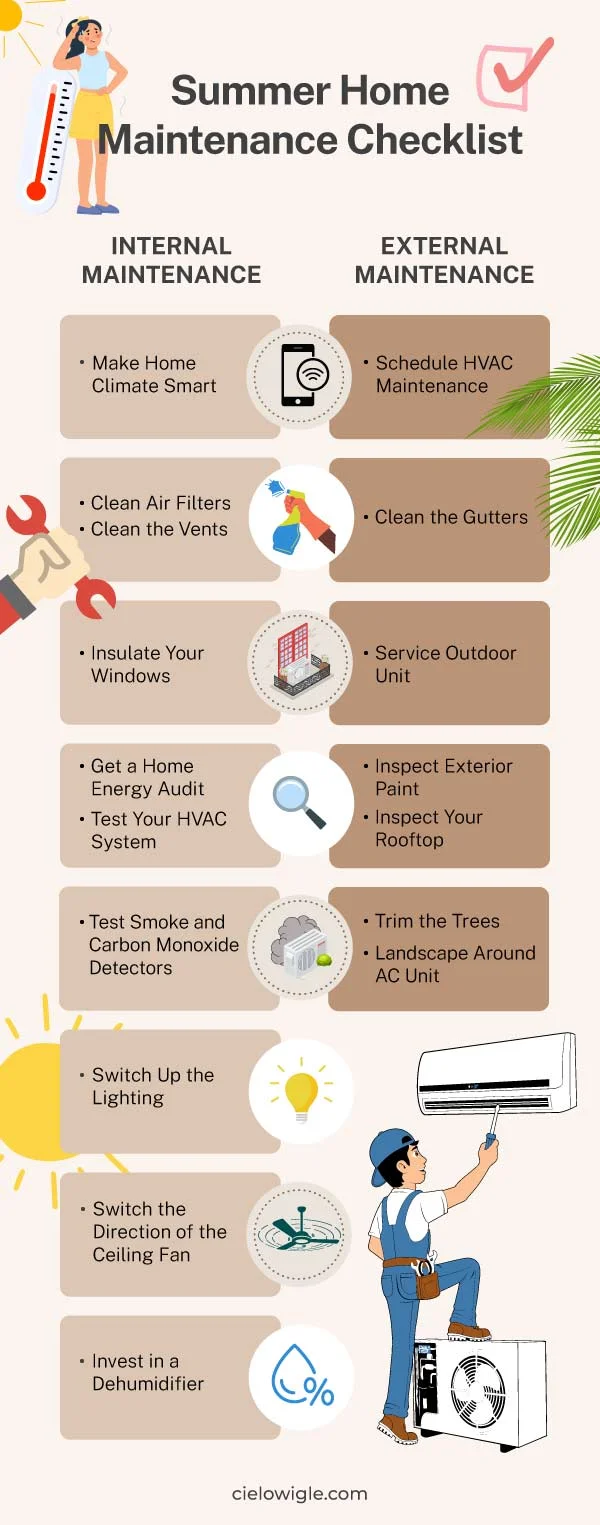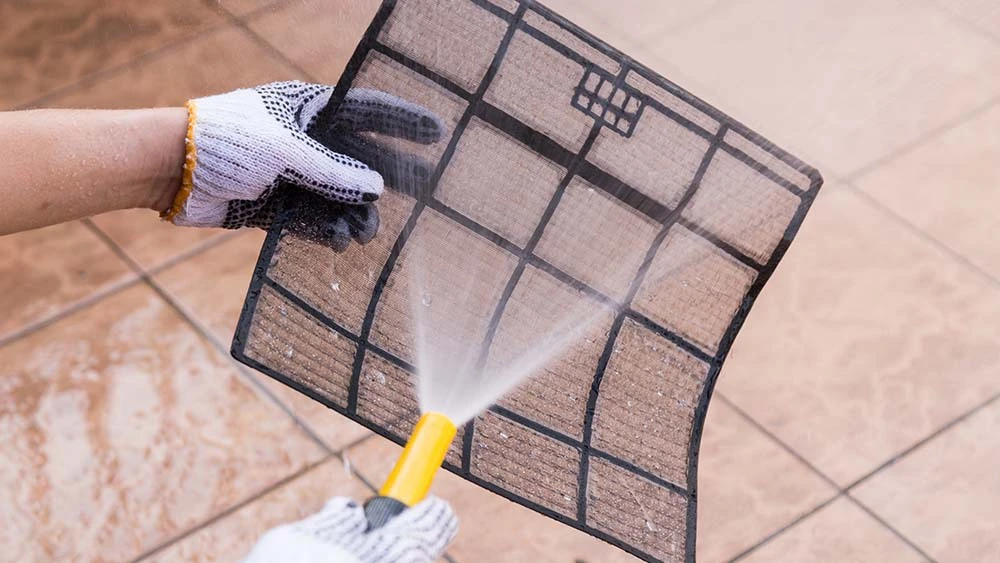
Key Takeaways
- Seal air leaks and insulate windows as part of your summer home maintenance checklist.
- Test your system, clean filters, and use smart thermostats to save energy.
- Clean gutters and downspouts to prevent water damage.
As the temperatures soar, it’s time to prepare your home for the ultimate summer experience. By taking some proactive steps, you can ensure that your summer is all about relaxation and having fun without any unexpected issues like sudden HVAC repairs or discomfort.
This comprehensive summer home maintenance checklist will guide you through essential tasks, both indoors and outdoors. Whether it’s tuning your air conditioning system or sprucing up your home exterior, this blog has everything you need to create a cozy environment for the season ahead.
Summer Home Interior Maintenance Checklist
Here’s a checklist to ensure your home’s interior is ready for the summer season:

1. Test Your HVAC System
Before the peak of summer arrives, it’s a good idea to test your HVAC system to make sure it’s ready to keep you cool when you need it most. Turn on your air conditioning and pay attention to a few key things: Is the air coming out of the vents as cold as it should be? Are there any strange noises coming from your AC unit? Do you notice any unusual AC smells?
If you detect anything out of the ordinary, it’s best to call in a professional to take a closer look and address any potential issues before they escalate.
Here’s a detailed spring HVAC maintenance checklist to get your AC in shape.
2. Make Your Home Climate Smarter
View this post on Instagram
Summer home maintenance is all about keeping your space cool and comfortable while saving on energy bills. That’s where smart thermostats for central and room AC units come in. These devices go beyond basic temperature control, offering a suite of smart features accessible right from your phone.
For instance, you can set schedules according to your routine so you don’t have to make manual adjustments constantly. With a geofencing feature, the thermostat will reduce your AC usage when your home is empty and adjust to your usual settings on your return.
Smart thermostats also provide real-time energy consumption data. You can track your usage pattern and make informed decisions to optimize your cooling strategy for maximum savings.
Equip your HVAC system with smart features and achieve the perfect balance between comfort & savings.
Learn more
3. Clean Air Filters
AC filters play a vital role in maintaining indoor air quality and the efficiency of your cooling system. A rule of thumb is to clean the filters every two weeks and replace them after three to four months.
If you constantly forget about your filter maintenance, mini-split thermostats for your room ACs can help. They send automatic reminders when your filters need cleaning.
Your best choice to make any mini-split, window,
or portable AC smart. Enhance your comfort and savings.

4. Clean the Vents
One often overlooked aspect of home maintenance is cleaning the vents. Over time, dust, debris, and allergens accumulate within the vents, preventing the cool air from circulating through your home evenly. Before the sweltering heat of summer sets in, take the time to clean your vents thoroughly. Not only does this improve your home air quality, but it also makes your AC work better.
5. Seal Air Leaks
![]()
Air leaks in your home can lead to significant energy loss as cool air escapes and hot air infiltrates, forcing your air conditioner to work harder to maintain a comfortable temperature. Inspecting windows, doors, ductwork, and other potential leakage points is essential. Sealing these leaks with weather stripping, caulking, or foam insulation can enhance your home’s energy efficiency.
6. Insulate Your Windows
Window inspection is a crucial component of your summer home maintenance checklist.
Start by washing the outside of your windows with lukewarm, soapy water to eliminate water spots and dust buildup.
Then, carefully examine the areas around your windows for cracks or gaps. These openings can cause air leaks and result in energy loss. In summer, 76% of direct light falling on your windows becomes heat. This can affect your home climate and make your AC work harder. Apply weatherstripping and caulking to seal the holes and cracks.
Additionally, invest in window treatments for extra insulation. You can opt for blinds or drapes. They can help to significantly block the heat entering from the windows. Film insulations for windows are another great option to reduce solar gain.
Here’s everything you need to know about window insulation.
7. Get a Home Energy Audit
A home energy audit, also known as a home energy assessment, is a comprehensive evaluation of your home’s energy use and efficiency. During an audit, a certified professional will inspect your home, looking for areas where energy is being wasted.
This could include poorly insulated areas and inefficient appliances. The auditor will then provide you with a report detailing their findings, along with recommendations for improvements.
It also includes your HVAC audit. The professionals will assess the overall performance of your HVAC system, identifying any inefficiencies, malfunctions, or areas for improvement. This evaluation can include inspecting ductwork, checking for leaks, examining insulation, and testing airflow.
8. Switch the Direction of Your Ceiling Fan
You can use ceiling fans to supplement your air conditioning. Fans can help distribute cool air more evenly and make you feel cooler, allowing you to set the thermostat a few degrees higher. This can help you stay comfortable while also saving on electricity bills.
Remember to turn off fans when you leave the room, as they only cool people, not spaces.
Related: Do Ceiling Fans Cool a Room? Here’s The Best Ceiling Fan Direction for Cooling
9. Test Smoke and Carbon Monoxide Detectors
Replace old batteries and check whether smoke and carbon monoxide detectors are in working order. This ensures they provide early warning in case of emergencies. It’s a simple yet crucial step in keeping your home safe.
10. Invest in a Dehumidifier
Consider investing in a dehumidifier for your home, especially if you live in a humid climate or struggle with allergies. By removing excess moisture from the air, a dehumidifier can create a more comfortable environment, making you feel cooler without needing to crank down the AC. It also combats allergy triggers like dust mites and mold, which thrive in damp conditions.
Additionally, dehumidifiers help protect your belongings from moisture damage and can even extend the lifespan of electronics by preventing rust.
Related: Dehumidifier vs Air Conditioner: Which Is Better?
11. Switch Up the Lighting
Traditional incandescent bulbs, halogen lights, decorative bulbs, and flood lights emit substantial heat while producing light. In fact, up to 90% of the energy used by incandescent bulbs is wasted on generating heat rather than actual light. In addition, this excess heat adds to your air conditioner’s workload, requiring it to work harder to maintain a comfortable temperature.
Replacing these inefficient bulbs with Compact Fluorescent Lamps (CFL) and Light-Emitting Diodes (LED) can significantly reduce energy consumption associated with lighting.
Summer Home Exterior Maintenance Checklist
Preparing the exterior of your home for the summer season is essential to ensure it remains both aesthetically pleasing and structurally sound. Here’s a checklist to help you tackle key maintenance tasks:
1. Inspect Exterior Siding and Paint
Check for any signs of wear, damage, or peeling paint. Addressing these issues early can help prevent further damage and deterioration, ensuring your home looks its best throughout the summer months.
Also, check your driveways and walkways for any signs of damage, such as cracks or holes in the pavement. It’s essential to check these issues promptly to prevent accidents like slips and falls.
2. Schedule Professional HVAC Maintenance

One of the best ways to prepare for rising temperatures is by scheduling a professional HVAC maintenance. This allows technicians to identify and address any minor issues that could escalate into major breakdowns when your system is under heavy use.
Annual HVAC maintenance cost typically ranges from $75 to $200,
The professional HVAC maintenance usually includes:
- Examining the condensate drain
- Checking electrical connections
- Checking refrigerant levels
- Fan lubrication
- Inspecting for physical damage to the unit
Related: HVAC Preventative Maintenance: Complete Guide With Checklist
3. Service Your Outdoor Unit
Give your outdoor HVAC unit a thorough cleaning to make sure it’s perfect during the summer months. Remove any debris, such as leaves, dirt, and grass clippings, that may have accumulated around the unit. Use a garden hose to gently wash away dirt and grime from the exterior of the unit. Trim any twigs and leaves around the unit to maintain adequate airflow.
4. Inspect Your Roof
Check for any signs of damage, such as loose or missing shingles, cracks, or areas where water may be pooling. Addressing these issues early can prevent them from worsening during the summer months when intense heat and occasional storms can exacerbate existing problems.
Apply a thick layer of roofing sealant to repair the broken shingle. Spread it evenly with a putty knife. If the shingle is missing, you will have to replace it.
5. Clean the Gutters
Cleaning the gutters before summer arrives is essential. Debris that has accumulated during the fall and winter months can clog gutters, leading to water buildup and potential damage to your home’s roof, walls, and foundation. By clearing out leaves, branches, and other debris, you can ensure proper drainage and prevent water from overflowing or seeping into unwanted areas. It’s a proactive measure that helps protect your home from potential water damage during the summer rains.
6. Landscape Around Your AC Unit
Direct exposure to sunlight can cause your AC unit to work harder to cool the air, leading to increased energy consumption and higher bills. By providing shade through landscaping, you reduce the amount of heat absorbed by the unit, allowing it to operate more efficiently.
When planning your landscaping, consider planting trees, shrubs, or tall bushes strategically around the perimeter of your AC unit, ensuring they provide adequate shade without obstructing airflow or access for maintenance. Additionally, low-maintenance and drought-resistant plants should be opted for to minimize the need for ongoing upkeep.
7. Trim the Trees
Trim the trees in your house so that the branches remain a safe distance from power lines, minimizing the risk of damage during summer storms. It’s also crucial to inspect trees for any signs of decay, such as cracks or hollowed limbs, which could potentially pose a threat. For larger or higher branches, it’s advisable to seek the assistance of tree care professionals, who can safely cut and remove them.
Ready, Set, Summer Ready!
From protecting your home against heat and humidity to creating a comfortable and inviting living space, a summer home maintenance checklist can help you stay organized and tackle essential tasks. From cleaning your AC to sealing air leaks, each task plays a vital role in maintaining the functionality and aesthetics of your home. So, gather your tools, set aside some time, and get to work on your home summer maintenance checklist!








